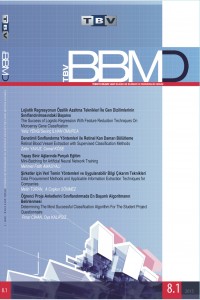Abstract
When the large data sets are modeling with Artificial Neural Networks, the training set is divided into mini-batches to parallelize training phase. In this way, training time is reduced. In this study, the effect of the mini-batch training was investigated when it applied to small data sets. In our experiments, 4 different learning algorithms over 11 datasets were used. It is shown that the mini-batch training is more successful than the full batch training with 3 learning algorithm.
Keywords
Artificial Neural Network Batch Learning Mini-batch Learning Stochastic Learning Machine Learning Optimization Artificial Intelligence
References
- LeCun Y., Bottou, L., Orr, G. ve Muller, K., 1998. “Efficient BackProp”, in Orr, G. and Muller K. (Eds), Neural Networks: Tricks of the trade, Springer.
- Wilson, D.R., Martinez, T.R., 2003, "The general inefficiency of batch training for gradient descent learning", Neural Networks, 16 (2003) 1429–1451, Elsevier.
- Dekel, O., Bachrach, R.G., Shamir, O., Xiao, L., 2012, "Optimal Distributed Online Prediction Using Mini-Batches", Journal of Machine Learning Research, 13 (2012) 165- 202.
- Gimpel, K., Das, D., Smith, N.A., 2010, "Distributed Asynchronous Online Learning for Natural Language Processing", CoNLL '10 Proceedings of the Fourteenth Conference on Computational Natural Language Learning, 213-222.
- Zhao, K., Huang, L., 2013, "Minibatch and Parallelization for Online Large Margin Structured Learning", Proceedings of NAACL- HLT 2013, 370–379.
- Cotter, A., Shamir, O., Srebro, N., ve Sridharan, K., 2011, "Better Mini-Batch Algorithms via Accelerated Gradient Methods", Advances in Neural Information Processing Systems (NIPS).
- Mİller, M.F., 1993, "A scaled conjugate gradient algorithm for fast supervised learning", NEURAL NETWORKS, 6(4), 525-533.
- Boyd, S., Vandenberghe, L., 2004, Convex Optimization, Cambridge University Press.
- Fletcher, R., 1987, Practical methods of optimization, New York: John Wiley & Sons.
- Igel, C., Hüsken, M., 2003, "Empirical evaluation of the improved Rprop learning algorithm", Neurocomputing, 50(C), 105-123.
- http://wangwzhao.googlepages.com/
- Blake, C.L., Merz, C.J., 1998, UCI Repository of www.ics.uci.edu/~mlearn/MLRepository.html Databases -
Abstract
Yapay sinir ağları ile büyük veri kümeleri modellenirken eğitimi paralelleştirmek için, eğitim kümesi ağa toptan yerine parçalara ayrılarak verilir. Bu sayede eğitim süresi azaltılır. Bu çalışmada parçalı eğitimin küçük veri kümelerine uygulandığındaki etkisi incelenmiştir. 4 farklı eğitim algoritması ve 11 veri kümesi üzerinde yapılan testlerde, 3 eğitim algoritması için parçalı eğitimin, toptan eğitimden daha başarılı olduğunu görülmüştür.
Keywords
Yapay Sinir Ağları Toptan Öğrenme Parçalı Öğrenme Tekil Öğrenme Makine Öğrenmesi Optimizasyon Yapay Zeka
References
- LeCun Y., Bottou, L., Orr, G. ve Muller, K., 1998. “Efficient BackProp”, in Orr, G. and Muller K. (Eds), Neural Networks: Tricks of the trade, Springer.
- Wilson, D.R., Martinez, T.R., 2003, "The general inefficiency of batch training for gradient descent learning", Neural Networks, 16 (2003) 1429–1451, Elsevier.
- Dekel, O., Bachrach, R.G., Shamir, O., Xiao, L., 2012, "Optimal Distributed Online Prediction Using Mini-Batches", Journal of Machine Learning Research, 13 (2012) 165- 202.
- Gimpel, K., Das, D., Smith, N.A., 2010, "Distributed Asynchronous Online Learning for Natural Language Processing", CoNLL '10 Proceedings of the Fourteenth Conference on Computational Natural Language Learning, 213-222.
- Zhao, K., Huang, L., 2013, "Minibatch and Parallelization for Online Large Margin Structured Learning", Proceedings of NAACL- HLT 2013, 370–379.
- Cotter, A., Shamir, O., Srebro, N., ve Sridharan, K., 2011, "Better Mini-Batch Algorithms via Accelerated Gradient Methods", Advances in Neural Information Processing Systems (NIPS).
- Mİller, M.F., 1993, "A scaled conjugate gradient algorithm for fast supervised learning", NEURAL NETWORKS, 6(4), 525-533.
- Boyd, S., Vandenberghe, L., 2004, Convex Optimization, Cambridge University Press.
- Fletcher, R., 1987, Practical methods of optimization, New York: John Wiley & Sons.
- Igel, C., Hüsken, M., 2003, "Empirical evaluation of the improved Rprop learning algorithm", Neurocomputing, 50(C), 105-123.
- http://wangwzhao.googlepages.com/
- Blake, C.L., Merz, C.J., 1998, UCI Repository of www.ics.uci.edu/~mlearn/MLRepository.html Databases -
Details
| Other ID | JA37NE75AG |
|---|---|
| Journal Section | Makaleler(Araştırma) |
| Authors | |
| Publication Date | June 24, 2016 |
| Published in Issue | Year 2015 Volume: 8 Issue: 1 |
Cite
Article Acceptance
Use user registration/login to upload articles online.
The acceptance process of the articles sent to the journal consists of the following stages:
1. Each submitted article is sent to at least two referees at the first stage.
2. Referee appointments are made by the journal editors. There are approximately 200 referees in the referee pool of the journal and these referees are classified according to their areas of interest. Each referee is sent an article on the subject he is interested in. The selection of the arbitrator is done in a way that does not cause any conflict of interest.
3. In the articles sent to the referees, the names of the authors are closed.
4. Referees are explained how to evaluate an article and are asked to fill in the evaluation form shown below.
5. The articles in which two referees give positive opinion are subjected to similarity review by the editors. The similarity in the articles is expected to be less than 25%.
6. A paper that has passed all stages is reviewed by the editor in terms of language and presentation, and necessary corrections and improvements are made. If necessary, the authors are notified of the situation.
. This work is licensed under a Creative Commons Attribution-NonCommercial 4.0 International License.
This work is licensed under a Creative Commons Attribution-NonCommercial 4.0 International License.


